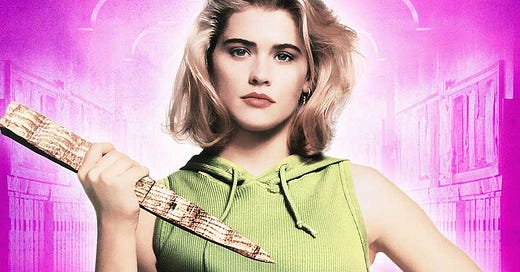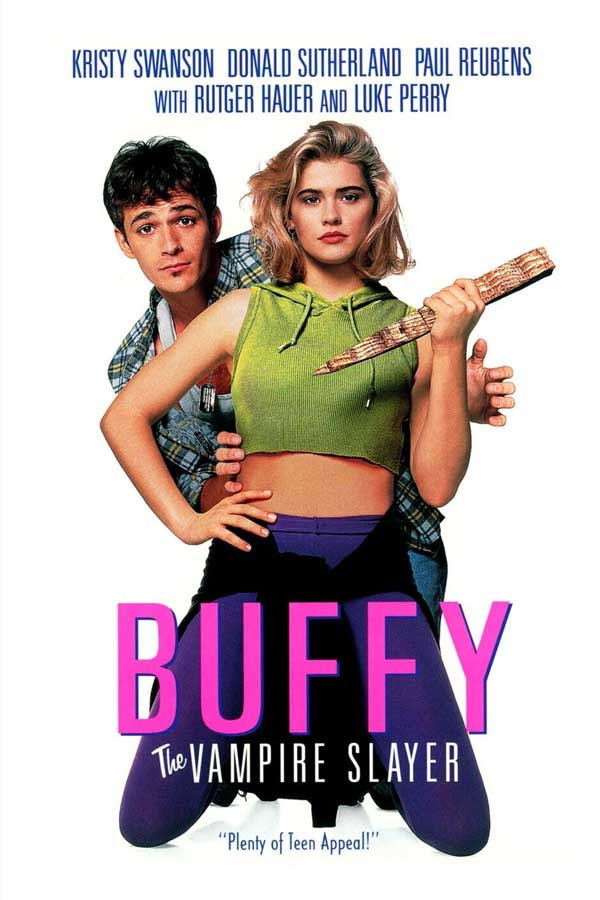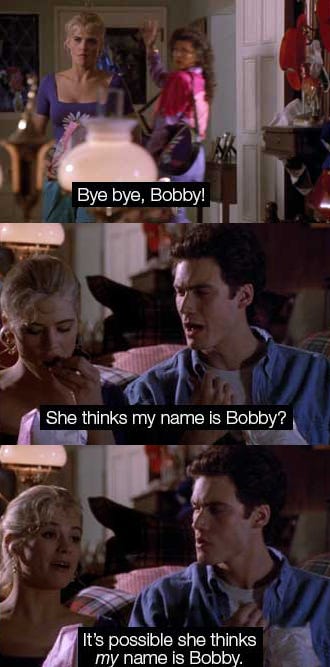Buffy the Vampire Slayer
Released: 31st July 1992
Written by: Joss Whedon
Directed by: Fran Rubel Kuzui
Buffy Summers is familiar to most from her eponym TV series, Buffy the Vampire Slayer, which to this day is an enduring staple of pop culture despite having ended way back in 2003.
The character remains synonymous with its star, Sarah Michelle Gellar, who slayed in every sense of the word as the embodiment of this cult TV superhero-cum-feminist icon over its seven-year run.
While Gellar’s is arguably the best incarnation of Buffy, hers was not the first. Five years before hitting the small screen, Buffy was introduced to the world in a 1992 feature-length film of the same name starring Kristy Swanson.
A critical and commercial flop, the film failed to make any lasting impact, a reputation made only more famous and prolonged by the subsequent ubiquity of the series which it has repeatedly been compared to since. Even more damning, writer and creator, Joss Whedon, has spoken candidly about the difficulties in getting his vision from page to screen, and his disappointment with the final product.
It didn’t turn out to be the movie that I had written. They never do, but that was my first lesson in that. Not that the movie is without merit, but I just watched a lot of stupid wannabe-star behaviour and a director with a different vision than mine—which was her right, it was her movie—but it was still frustrating.
Joss Whedon, AV Club, 2001
Poorly-received all round, the film has never managed to shake off its legacy as a dud, and is universally derided when mentioned in the same breath as its much more successful TV counterpart.
But, as Whedon himself admits, the film is not without merit, and it’s a shame that this is rarely considered. Firstly, Whedon’s core idea is very much present: subverting the victim-prone ditsy blonde trope to one who, while still holding many of those characteristics, is also powerful and multi-dimensional. Even by the early 90s heroic female characters were still something of a rarity, especially those who managed to be formidable while not at the expense of their femininity. Secondly, the dialogue is brimming with Whedon’s trademark quips, which (liked or loathed) were central to the appeal of the series. Though it could quite fairly be dismissed as nothing more than a fun but silly film, the unique qualities brought by Whedon should at least set it apart from the temptation to write it off as an unmitigated disaster.
I first watched the film years before the series had ever materialised – without the internet to tell me how “bad” it was (and, to be fair, with a much less discerning pre-teen point of view) – so was able to enjoy it just for what it was, and three decades on I think it still holds up. So, if you need a little convincing, here’s a look at all the reasons why Buffy the film doesn’t suck!
Once More, Without Flopping
The elephant in the room (which has already been noted, but bears repeating) is how the series very clearly outdoes the film by every possible metric, so to make comparisons based on overall quality would be pointless, and we’re not here to do that.
Joss and I always talk about [a movie], but the thing with Buffy is that Buffy was a movie, and it ultimately didn’t work as a film. And I mean, we had such miles to overcome when we were trying to do a TV show based on a movie. And one of the reasons is that the story works better over time.
Sarah Michelle Gellar, E! News, 2013
As well as the massively different storytelling formats, the five year gap that separates them, while not a huge amount of time, definitely accounts for significant differences in style and tone. The series’ proximity to the cusp of the new millennium gives it a relatively modern edge compared to the heady days of 1992 which more intensely evoke the qualities of everything that makes that decade feel dated. More worthwhile is looking at what the film has that the series lacks, and to what extent the former influenced the latter.
With the film plotting Buffy’s origin as the slayer, there is some overlap in the story that extends to the series, though over the years this has become somewhat muddied. The series’ pilot episode begins with Buffy having recently moved to Sunnydale from Los Angeles. It’s quickly established that the Summerses are trying to move on from a past they’d rather forget, while dropping her off on her first day of school Joyce offers some well-intentioned but candid parting motherly advice:
Allusions to events of the film are specific enough to suggest that this serves as a continuation of that story, but not everything lines up quite so neatly. Principal Flutie (RIP) notes her previous attendance at Hemery High – the same school in the film – and her expulsion after burning down the vampire- asbestos-ridden gym. While the gruesome final act of the film does indeed take place in the school gym, there’s no real indication that it subsequently went up in flames by Buffy’s doing. Another notable inconsistency is Buffy’s age; though not stated in the film, she is already a senior so presumably older than in the series where she begins as a 16-year-old sophomore. The one remaining bridge between the two mediums comes in the form of a short flashback sequence at the end of season two showing a tenuously similar but abbreviated version of how Buffy met her first watcher, and the discovery of her birthright. Apart from Merrick’s name in credit only and Gellar’s decidedly air-headed valley girl take on pre-Sunnydale Buffy, there’s little sense that in telling the story of her past there was any intention to specifically elicit memories of the film.
Comic miniseries, The Origin, released in 1999, retells the events of the film adapted from Whedon’s original script with the intention of serving as a true prequel to the series, essentially hybridising the two. With Whedon more or less stating that it can be accepted as canon, this does effectively sever any ties between the film and the series in that respect.
Two more characters lucky enough to appear in both formats – though with very different characterisations – are Buffy’s parents, known in the film simply as ‘Mom’ and ‘Dad’, getting an upgrade for the series to Joyce and Hank Summers, respectively. Whereas in the series we have Joyce as the quintessential loving and well-intentioned suburban TV mother (Hank shown as little more than an absentee father) in the film they make a brief but memorable appearance portrayed quite antithetically as vacuous, wealthy, dim-witted Beverly Hills-types i.e. exactly the kind of people who’d name their kid ‘Buffy’.
Though it’s interesting to see the polar opposite interpretations of what Buffy’s parents could look like, they definitely both make complete sense in their own formats. In the film, her character arc is predominantly about becoming less self-involved to take on her responsibilities as the slayer, so Mom and Dad are an effective representation of the environment she begins as the product of. By the time we get to the series that character development has already happened, and is now much more about managing her slayer responsibilities alongside trying to have a normal-ish life, so it’s fitting that she also has a normal-ish parent to enable that particular struggle. It might have been quite funny to keep original ‘Mom’ in the series, but unless we think Joyce moved from LA to Sunnydale via Snog Marry Avoid? it’s fair to say that the character was just completely revamped to be more of a thoughtful and engaged motherly figure, providing both stability and contention in Buffy’s continued journey.
Taking a step back from the finer details, one of the broader differences that really sets the two apart is the overall tone: Buffy the series is campy, Buffy the film is CAMP. Another compromise made to Whedon’s dissatisfaction, where he had intended the original story to be dark with a sense of humour (later exemplified well in his own TV production), the film turned out to be more of a frivolous horror/comedy. The good news for fans being, if you’re willing to lean into that you’re going to have a lot more fun.
A killer cast
For all its criticisms, the film boasts a surprisingly impressive cast of familiar faces – including a whopping THREE future Oscar winners – who all do a great job of wielding their innate star power.
Kristy Swanson as Buffy Summers
Ironically as the lead performer, Swanson is probably one of the least well-known nowadays from this list (though has continued to work steadily to date), but is charismatic enough to lead us through Buffy’s journey from vapid cheerleader to butt-kicking slayer. The film begins with Buffy as part of a mean girls clique who collectively share a brain cell between them, though she does stand out as having a bit more to her, and Swanson does a competent job of embodying both sides of the character. Though it’s hard to imagine anyone else being able to offer the range and depth Gellar provided in the series, Swanson definitely deserves props for her own take in the film.
Donal Sutherland as Merrick
Adding some gravitas to the cast while being a menace on set, Sutherland famously rubbed Whedon up the wrong way with allegations of rewriting his own lines and being rude to everyone. As Buffy’s first watcher, Sutherland is stern and nurturing in equal measure, though Merrick lacks the more layered warmth of the series’ Rupert Giles.
Hilary Swank as Kimberly
Ladies and gentlemen: two-time Academy Award® winner, Hilary Swank, doing a fabulous job of playing the meanest mean girl in her big screen debut with a rare but well-executed comedic performance.
Luke Perry as Pike
The eminent 90s teen heartthrob, admist the height of his Beverly Hills, 90210 fame Perry is as dreamy and lovable as you’d expect in the role of Buffy’s nuisance/love interest.
David Arquette as Benny
Arquette doing what he does best in one of his early roles playing the mischievous sidekick to Pike, featuring in a particularly memorable scene with a hot dog.
Rutger Hauer as Lothos
As well as being one of Buffy’s most fashionably-dressed adversaries, Hauer brings an unexpected level of camp to his performance as generations-old Lothos which really cements the enjoyment to be had in not taking things very seriously.
Paul Reubens as Amilyn
Stealing every scene he’s in, Reubens is about as far away from Pee-wee Herman as you can get in the role of Lothos’ loyal minion, giving hilarity and a healthy dose of gay subtext. Swanson admitted at a 2021 panel talk that this (spoilery) scene with Reubens was one of the hardest to get through just because she couldn’t keep a straight face.
Ben Affleck as Basketball Player #10 (uncredited)
Ok this is a reach as he doesn’t have any lines and his Oscar wins weren’t even for acting, but I bet he still makes J-Lo watch this.
A few more notable famous faces include Stephen Root (Office Space), Thomas Jane (Hung), with some blink-and-you’ll-miss-them appearances from Ricki Lake, Alexis Arquette, and Buffy series alumn Seth Green.
Given the chance, Buffy the film might have been able to salvage itself as a future cult film, but was perpetually eclipsed by the series’ success. Would I give up the existence of the series just for the film to retrospectively have its day? Obviously not, but at the same time were it not for the film’s existence we may not have even had the series, and certainly not in the iconic form we know and love.
Whether you’re a fan of the series or not (but especially if you are), if you haven’t seen the film because you believed the bad press or it just flew under your radar, give it a chance with fresh eyes and you might have a newfound love for this camp classic.
Watch the trailer
This article was originally published on the Pop Warrior blog, 31 December 2022
Where to watch
Buffy the Vampire Slayer is available to buy on DVD and Blu-ray
Find out where you can stream or purchase digitally on JustWatch UK | USA
(you can also check availability in other countries using the filter)
🗨️ Join the discussion
Do you think the 1992 Buffy the Vampire Slayer film deserves more love?



















